27.04.2022
NASA gives green light for OSIRIS-REx spacecraft to visit another asteroid
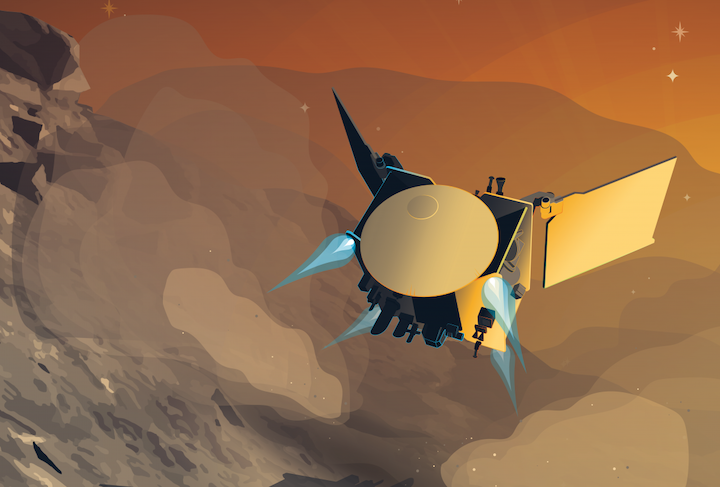
NASA's OSIRIS-REx spacecraft will swing by Earth to deliver a sample from asteroid Bennu on Sept. 24, 2023. But it won't clock out after that.
NASA has extended the University of Arizona-led mission, which will be renamed OSIRIS-APEX, to study near-Earth asteroid Apophis for 18 months. Apophis will make a close approach to Earth in 2029.
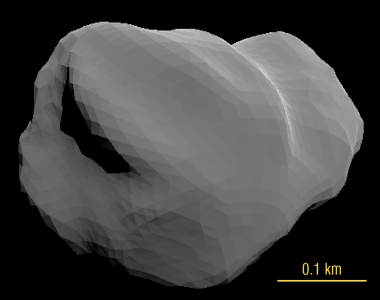
The University of Arizona will lead the mission, which will make its first maneuver toward Apophis 30 days after the OSIRIS-REx spacecraft delivers the sample it collected from Bennu back in October 2020. At that point, the original mission team will split – the sample analysis team will analyze the Bennu sample, while the spacecraft and instrument team transitions to OSIRIS-APEX, which is short for OSIRIS-Apophis Explorer.
Regents Professor of Planetary Sciences Dante Lauretta will remain principal investigator of OSIRIS-REx through the remaining two-year sample return phase of the mission. Planetary sciences assistant professor and OSIRIS-REx deputy principal investigator Dani DellaGiustina will then become principal investigator of OSIRIS-APEX. The extension adds another $200 million to the mission cost cap.
The mission team did an exhaustive search for potential asteroid targets. The OSIRIS-REx spacecraft was built for what's called a rendezvous mission, meaning instead of making a single flyby of an object and quickly snapping images and collecting data, it was designed to "get up close and personal with the object." DellaGiustina said. "Our spacecraft is really phenomenal at that."
"Apophis is one of the most infamous asteroids," DellaGiustina said. "When it was first discovered in 2004, there was concern that it would impact the Earth in 2029 during its close approach. That risk was retired after subsequent observations, but it will be the closest an asteroid of this size has gotten in the 50 or so years asteroids have been closely tracked, or for the next 100 years of asteroids we have discovered so far. It gets within one-tenth the distance between the Earth and moon during the 2029 encounter. People in Europe and Africa will be able to see it with the naked eye, that's how close it will get. We were stoked to find out the mission was extended."
OSIRIS-REx was launched in 2016 to collect a sample from Bennu that will help scientists learn about the formation of the solar system and Earth as a habitable planet. OSIRIS-REx is the first NASA mission to collect and return a sample from a near-Earth asteroid.
OSIRIS-APEX will not collect a sample, but when it reaches Apophis, it will study the asteroid for 18 months and collect data along the way. It also will make a maneuver similar to the one it made during sample collection at Bennu, by approaching the surface and firing its thrusters. This event will expose the asteroid's subsurface, to allow mission scientists to learn more about the asteroid's material properties.
The scientists also want to study how the asteroid will be physically affected by the gravitational pull of Earth as it makes its close approach in 2029.
They also want to learn more about the composition of the asteroid. Apophis is about the same size as Bennu – nearly 1000 feet at its longest point – but it differs in what's called its spectral type. Bennu is a B-type asteroid linked to carbonaceous chondrite meteorites, whereas Apophis is an S-type asteroid linked to ordinary chondrite meteorites.
"The OSIRIS-REx mission has already achieved so many firsts and I am proud it will continue to teach us about the origins of our solar system," said University of Arizona President Robert C. Robbins. "The OSIRIS-APEX mission extension keeps the University of Arizona in the lead as one of the premier institutions in the world to study small bodies with spacecraft and demonstrates again our incredible capacity in space sciences."
DellaGiustina is also excited that the mission provides an excellent opportunity for early career scientists to gain professional development. OSIRIS-REx veterans will work closely with these early career scientists as mentors in the early mission phases. By the time the spacecraft arrives at Apophis, the next generation will step into leadership roles on OSIRIS-APEX.
"OSIRIS-APEX is a manifestation of a core objective of our mission to enable the next generation of leadership in space exploration. I couldn't be prouder of Dani and the APEX team," Lauretta said. "Dani first started working with us in 2005 as an undergraduate student. To see her take on the leadership of the mission to asteroid Apophis demonstrates the outstanding educational opportunities at the University of Arizona."
Quelle: University of Arizona
----
Update: 28.04.2022
.
NEW TARGET FOR ASTEROID PROBE: “POTENTIALLY HAZARDOUS” APOPHIS
Once the primary mission of NASA’s OSIRIS-REx is complete, the spacecraft will head toward a new destination: near-Earth asteroid Apophis.
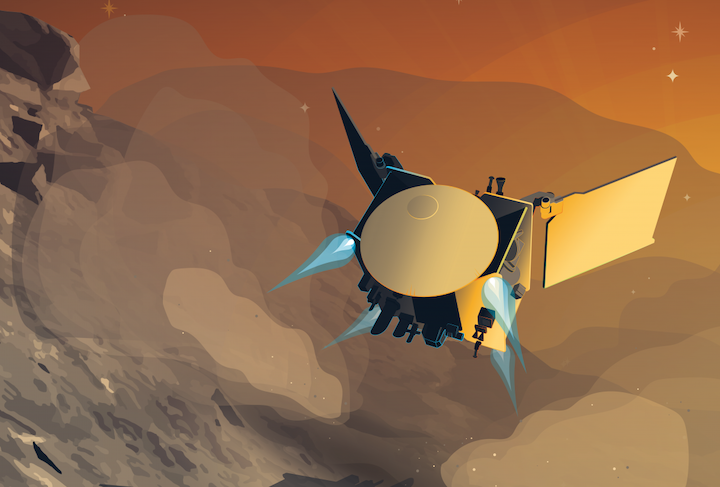
Once an asset is in space and functioning, it only makes sense to repurpose it and obtain the most science bang for the buck. In that vein, NASA announced yesterday that it will grant extensions for eight missions currently underway. While most missions were extended three years, one was extended for nine: The Origins, Spectral Interpretation, Resource Identification, Security, Regolith Explorer (Osiris-REX) spacecraft, which just visited and sampled the asteroid 101955 Bennu and is due to drop off samples at Earth late this year, will continue onward toward another target of opportunity: the potentially hazardous asteroid 99942 Apophis.
The extension will see the mission re-designated as Osiris-APEX (Apophis Explorer). It will encounter Apophis in 2029, shortly before the asteroid's closest Earth approach, and spend the next 18 months exploring the worldlet.
“We were stoked to find out the mission was extended,” says Daniella DellaGiustina (University of Arizona), who was named principal investigator of the extended mission. The spacecraft is uniquely designed for the sort of close rendezvous and imaging that's required. “Our spacecraft is really phenomenal at that,” she adds.
"Osiris-APEX will detect Apophis about three weeks before the asteroid's close encounter with Earth, giving us time to monitor its rotation rate before and after the close encounter," says DellaGiustina. "After that the spacecraft will spend 18 months surveying the asteroid, including going into a close orbit around this small object."
Launched on September 8, 2016, atop an Atlas-V rocket from Cape Canaveral, Osiris-REX reached Bennu in December 2018, and collected samples from the asteroid in October 2020. Now headed back to Earth aboard Osiris, the sample capsule will reenter Earth’s atmosphere on September 24, 2023, over the Air Force’s Utah Test and Training Range.
Research operations at the University of Arizona will split once the sample return capsule departs the main spacecraft, with the Osiris-REX team completing recovery and analysis of the sample, and the Osiris-APEX team managing the continuation toward Apophis. The mission extension adds an additional $200 million to the budget.

NASA Goddard / University of Arizona / Lockheed Martin
Other NASA missions granted extensions include New Horizons and the Lunar Reconnaissance Orbiter, as well as five Martian missions: MAVEN, Mars Odyssey, the Mars Reconnaissance Orbiter, the Curiosity rover, and the InSight lander.
OSIRIS-REX isn't the only mission heading to a second target. The Japanese Hayabusa 2 mission will head to the asteroids 2001 AV43 in 2029 and 1998 KY26 in 2031, respectively, and China’s Chang’e 5 orbiter headed to a new orbit after grabbing samples from the Moon. It will perform solar observations and possibly search for asteroids at the Sun-Earth Lagrange points.
WHAT DO WE KNOW ABOUT APOPHIS?
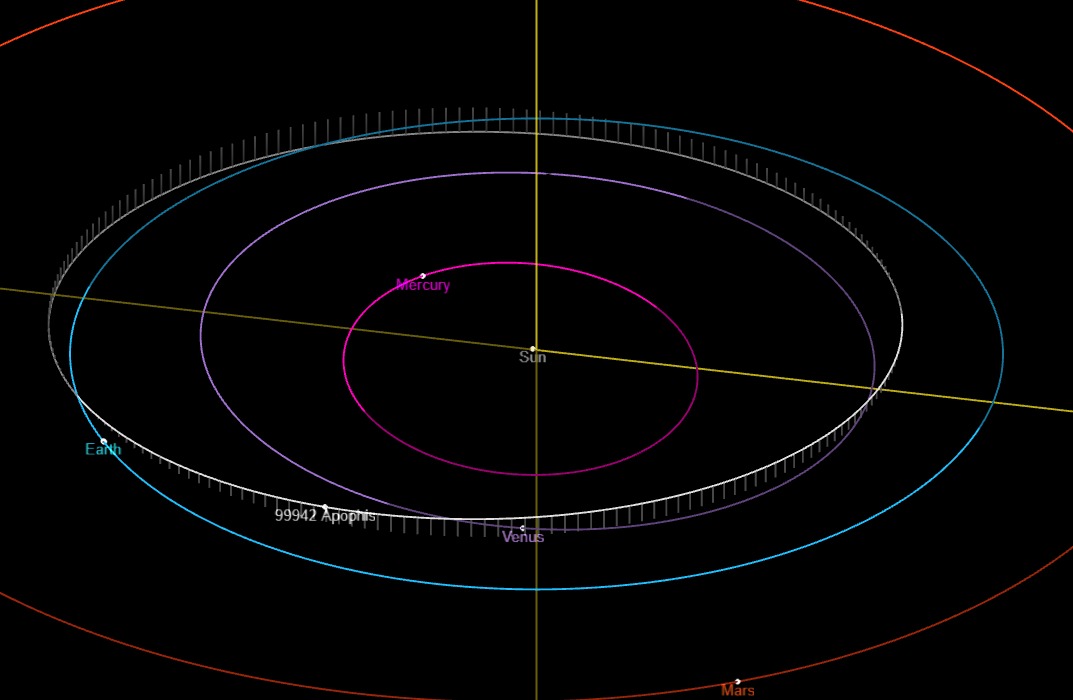
NASA / JPL
Apophis is a potentially hazardous asteroid, labeled such because its orbit crosses that of Earth. Its discovery back in 2004 caused quite a stir when researchers calculated a small chance it would impact the Earth on April 13, 2029. Later observations refined the orbit and ruled out that possibility, but Apophis will still miss us by just 19,600 miles in 2029, 10 times closer than the Moon and inside geostationary orbit. The 700-meter (1,200-foot) rock will be visible as a 3rd-magnitude moving “star” from Europe, Africa, and western Asia.
Osiris-APEX’s close-up look will tell us if Apophis is a loose rubble-pile like Bennu, or something more substantial. Apophis is known from spectral analysis to be an S-type chondrite, versus the B-type carbonaceous chondrite Bennu, so it should provide some contrast for study. Scientists also plan to use the spacecraft’s gas thrusters to attempt to dislodge and study the dust and small rocks on and below Apophis’s surface.
"Apophis' bulk structure and surface strength have important implications for planetary defense," says DellaGiustina. "As a 'stony' S-type asteroid, Apophis represents the most common class of potentially hazardous asteroids and knowledge of its properties can inform planetary defense mitigation strategies."

University of Arizona / JPL / Arecibo
These future plans were announced right after the release of the Planetary Science Decadal Survey last week, which specifically mentioned the possibility of exploring Apophis. We’re truly entering in the age of asteroid exploration now, as we are for the first time getting multiple close-up views of these tiny worlds.
NASA Prepares for Historic Asteroid Sample Delivery on Sept. 24

NASA's OSIRIS-REx spacecraft is cruising back to Earth with a sample it collected from the rocky surface of asteroid Bennu. When its sample capsule parachutes down into the Utah desert on Sept. 24, OSIRIS-REx will become the United States’ first-ever mission to return an asteroid sample to Earth.
After seven years in space, including a nail-biting touchdown on Bennu to gather dust and rocks, this intrepid mission is about to face one of its biggest challenges yet: deliver the asteroid sample to Earth while protecting it from heat, vibrations, and earthly contaminants.
“Once the sample capsule touches down, our team will be racing against the clock to recover it and get it to the safety of a temporary clean room,” said Mike Moreau, deputy project manager at NASA's Goddard Space Flight Center in Greenbelt, Maryland.
So, over the next six months, the OSIRIS-REx team will practice and refine the procedures required to recover the sample in Utah and transport it to a new lab built for the material at NASA’s Johnson Space Center in Houston. There, scientists will unpack the sample, distribute up to a quarter of it to the OSIRIS-REx science team around the world for analysis, and curate the rest for other scientists to study, now and in future generations.
Flight dynamics engineers from NASA Goddard and KinetX Aerospace are reviewing the trajectory that will bring the spacecraft close to Earth. At Lockheed Martin in Denver, team members are keeping tabs on the spacecraft and preparing a group to recover the sample capsule. This summer, crews in Colorado and Utah will practice all of the steps to recover the capsule safely, while protecting it from contamination. At Johnson Space Center, the curation team is rehearsing their procedure to unpack and process the sample inside glove boxes. Meanwhile, members of the sample science team are preparing the investigations they will perform with the sample material once received.
“The OSIRIS-REx team has already performed amazing feats characterizing and sampling asteroid Bennu,” said Dante Lauretta, OSIRIS-REx principal investigator from the University of Arizona, Tucson. “These accomplishments are the direct result of the extensive training and rehearsals that we performed every step of the way. We are bringing that level of discipline and dedication to this final phase of the flight operations.”
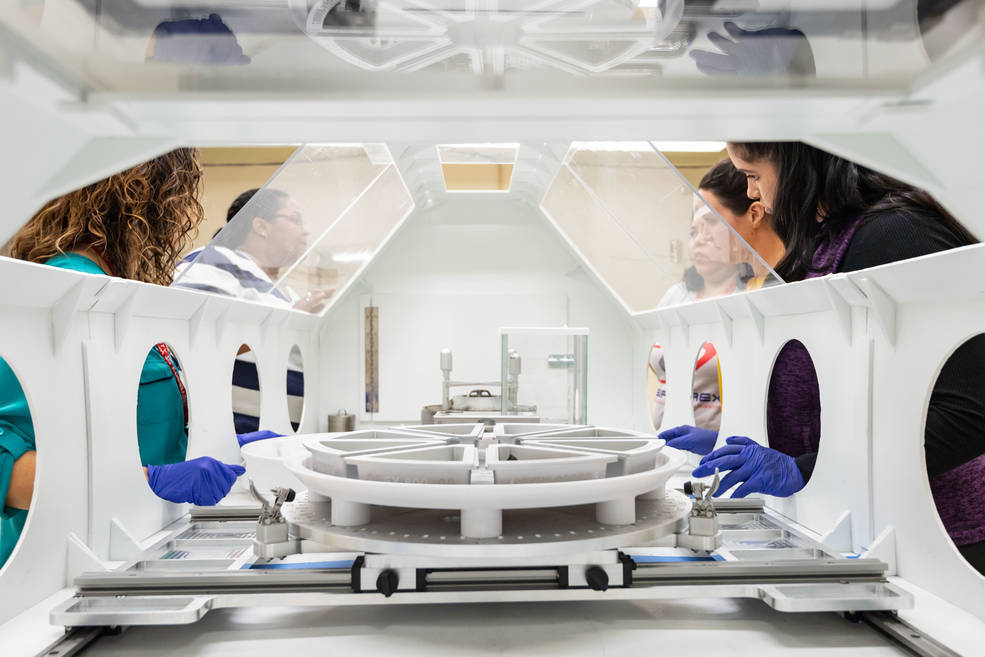
Asteroids are the ancient materials left over from the original era of planet formation and may contain molecular precursors to life. Scientists have learned a great deal from studying asteroid fragments that have naturally reached the ground as meteorites. But to understand whether asteroids played a role in delivering these compounds to Earth’s surface over 4 billion years ago, scientists need a pristine sample from space, free from terrestrial contaminants.
In addition, the most fragile rocks observed on Bennu probably would not have survived passage through Earth’s atmosphere as meteorites. “There are two things pervasive on Earth: water and biology,” said Dr. Jason Dworkin, OSIRIS-REx project scientist at NASA Goddard. “Both can severely alter meteorites when they land on the ground and muddle the story told by the sample’s chemistry and mineralogy. A pristine sample could provide insights into the development of solar system.”
On Sept. 24, as the OSIRIS-REx spacecraft flies by Earth, it will release its sample return capsule, thereby ending its primary mission. The capsule, which is estimated to hold about a cup of Bennu’s material – 8.8 ounces +/- 3.6 ounces (250 grams +/- 101 grams) to be precise – will land within a 37-mile by 9-mile ellipse (59 km by 15 km) within Department of Defense property that is part of the Utah Test and Training Range and Dugway Proving Grounds.
OSIRIS-REx team members from NASA Goddard, KinetX, Lockheed Martin, and NASA's Langley Research Center in Hampton, Virginia, are using computer models to test navigation plans in various weather, solar activity, and space debris scenarios to ensure that when the capsule enters Earth’s atmosphere at 10:41 a.m. ET (8:41 a.m. MT), it will touch down inside the targeted area 13 minutes later.
Recovery crews are responsible for securing the sample return capsule’s landing site and helicoptering it to a portable clean room located at the range. Additionally, crews will collect soil and air samples all around the landing capsule. These samples will help identify if any minute contaminants contacted the asteroid sample.
Once the capsule is inside the building with the portable clean room, members of the team will remove the heat shield, back shell, and other components to prepare the sample canister for transport to Houston.
The return to Earth of samples from asteroid Bennu will be the culmination of a more than 12-year effort by NASA and its mission partners but marks the beginning of a new phase of discovery as scientists from around the world will turn their attention to the analysis of this unique and precious material dating from the early formation of our solar system.
Quelle: NASA
----
Update: 13.04.2023
.
NASA ENVISIONS INTERNATIONAL FLEET OF APOPHIS RECONNAISSANCE SPACECRAFT
NASA officials are encouraging the international space community to launch several small spacecraft to study the asteroid Apophis before it makes a close approach to Earth in 2029. It is more of a concept than a plan at this stage, but the idea is to get imagery and other data before the encounter to compare with data that will be acquired by another spacecraft — already in space — afterwards to add to the planetary defense knowledge base for the day an Earth-threatening asteroid is on its way.
Apophis will come within 20,000 miles (32,000 kilometers) of Earth’s surface on April 13, 2029. Scientists have calculated and recalculated its orbit and are certain it poses no danger to Earth, but it will be visible with the naked eye in the Eastern Hemisphere and certain to capture the public’s attention.
Ground-based telescopes will get quite a view as it speeds by, but the planetary defense community wants much more data, especially before and after images to see how the interaction with Earth affects the 1,100-foot (340-meter) diameter asteroid.
At the 8th Planetary Defense Conference in Vienna, Austria last week, Bhavya Lal, NASA Associate Administrator for Technology, Policy and Strategy, explained the idea and its rationale. Speaking virtually, she called for a “small fleet” of spacecraft to do reconnaissance of Apophis before its date with Earth.
“Space agencies should work together to develop a small fleet of robotic spacecraft to go out ahead of April ’29 and meet the asteroid before its close approach to Earth.
“Nature has provided us with such a prime opportunity to demonstrate our space mission prowess, in this case to perform rapid reconnaissance of an approaching object that might be an impact threat. To learn all we can about it and inform any action we might need to take to mitigate potential disaster. … We believe protection of our planet from cosmic hazards is a global issue that affects the interests of more than any one nation.” — Bhavya Lal
In an interview today, Lal told SpacePolicyOnline.com that she was delivering an “inspirational” message on behalf of NASA Administrator Bill Nelson, not announcing a new NASA program. Mission concept studies are underway, but there is no funding in the current budget for such a mission.
However, the 2022 Decadal Survey for planetary science and astrobiology recommended just such a “rapid reconnaissance” mission. The Biden-Harris U.S. Space Priorities Framework asserts the United States will lead efforts “to enhance warning of and mitigation against potential near-Earth object impacts.” And just last week, the White House Office of Science and Technology Policy released an updated National Preparedness Strategy and Action Plan for Near-Earth Object Hazards and Planetary Defense.
Lindley Johnson, NASA’s Planetary Defense Officer and head of the agency’s Planetary Defense Coordination Office, told SpacePolicyOnline.com today that there is plenty of time. A spacecraft could launch well into 2028 and still get there soon enough to do at least a flyby, though a rendezvous, where the spacecraft would go into orbit around Apophis, would take longer in order to complete the “gymnastics” needed to match the asteroid’s speed.
He said there is subtantial interest in the planetary defense community and ESA already has some money allocated to the concept. Although there’s nothing in NASA’s current budget, he said they are looking at next year’s. Cubesats are a definite possibility, perhaps building on the success of Italy’s LICIACube that accompanied the DART mission when it impacted Dimorphos last year.
The science community is very excited about what they’ll be able to learn from Apophis’s close approach and annual conferences are being held as the clock counts down to 2029. “Apophis T-6 Years: Knowledge Opportunities for the Science of Planetary Defense” takes place next month. Johnson said that will be the next chance for the community to discuss and coordinate plans. He thinks it “quite likely” at least one spacecraft will get to Apophis before April 2029.

Illustration credit: University of Arizona Lunar & Planetary Laboratory.
NASA already has a spacecraft that will observe Apophis after it passes by. The OSIRIS-REx mission is on its way back to Earth right now to deliver samples it collected from the asteroid Bennu. The sample return container will separate from the main spacecraft and land in Utah on September 24, but the main spacecraft will continue on an extended mission dubbed OSIRIS-Apophis Explorer or OSIRIS-APEX. It will rendezvous with Apophis and go into orbit for 15 months then use its thrusters to dig into the surface.
NASA and others in the planetary defense community also want to use Apophis’s close approach as an opportunity to educate people around the globe about the threats posed by asteroids. They plan to propose that the United Nations declare 2029 as the International Year of Planetary Defense. At last week’s Planetary Defense Conference, NASA’s Doris Daou laid out the objectives.
It’s a lengthy process that will begin with a proposal to the U.N. Committee on the Peaceful Uses of Outer Space (COPUOUS) perhaps next year.
Quelle: SPACEPOLICYONLINE.COM
